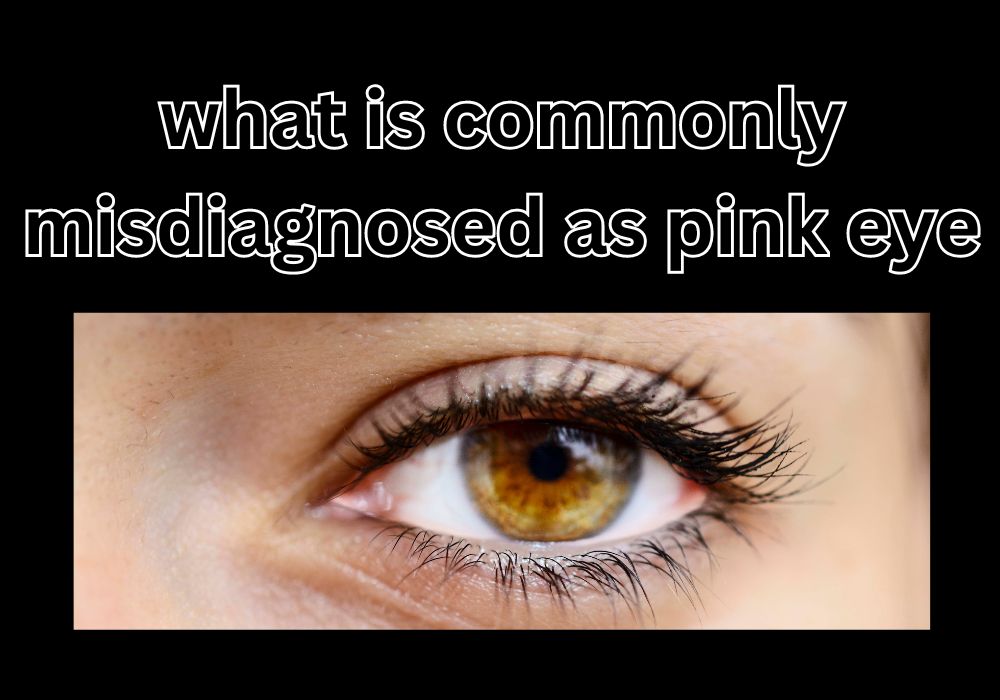Conjunctivitis, sometimes known as pink eye, is a common eye ailment that results in conjunctival irritation and redness. While it’s a prevalent ailment, there are instances where other conditions are mistakenly identified as pink eye. In this article, we’ll explore what commonly gets misdiagnosed as pink eye and the implications of such errors.
Introduction
Definition of Pink Eye
Pink eye is an inflammation of the thin, transparent layer covering the white part of the eye and the inside of the eyelids. Viral or bacterial infections, allergies, or irritants often cause it. The disease is highly contagious and spreads quickly, especially in populated regions.
Rates and Inaccurate Diagnoses
Pink eye is so widespread that it’s often the go-to diagnosis for red, irritated eyes. However, this can lead to misdiagnoses, as several other eye conditions share similar symptoms.
Commonly Misdiagnosed Conditions
Allergic Conjunctivitis
Allergies can cause redness and eye irritation, mimicking the symptoms of pink eye. Identifying the specific allergen is crucial for accurate diagnosis and treatment.
Dry Eye Syndrome
Insufficient tear production or poor-quality tears can result in dry eyes, which may be confused with pink eye due to similar discomfort and redness.
Bacterial and Viral Infections
Other infections, such as styes or herpes simplex, may be mistakenly labeled as pink eye, emphasizing the need for precise diagnostic measures.
Symptoms and Overlapping Signs
Redness and Irritation
Red eyes are a hallmark of pink eye, but various conditions can cause redness. Understanding additional symptoms is vital for differentiation.
Watery Eyes
While tearing is common in pink eye, excessive tearing can also be a symptom of other conditions, demanding a more nuanced assessment.
Sensitivity to Light
Photophobia, or light sensitivity, is a symptom many eye conditions share. It was pinpointing its cause aids in accurate diagnosis.
Importance of Accurate Diagnosis
Potential Complications
Misdiagnosing a more severe condition, such as pink eye, can lead to delayed treatment, potentially resulting in complications like corneal damage.
Proper Treatment
Each eye condition requires specific treatment approaches. A misdiagnosis could mean ineffective treatment, prolonging discomfort.
Differentiating Factors
Medical History
Understanding the patient’s medical history thoroughly provides crucial insights into the potential causes of eye irritation.
Physical Examination
A comprehensive eye examination, including specialized instruments, helps discern specific indicators of various eye conditions.
Laboratory Tests
Sometimes, laboratory tests may be necessary to identify the causative agent, ensuring an accurate diagnosis.
Prevention and Hygiene
Proper Handwashing
Emphasizing the importance of hand hygiene helps prevent the spread of infections that can lead to pink eye.
Avoiding Touching Eyes
Discouraging eye rubbing and touching reduces the risk of irritants entering the eye and causing symptoms.
Keeping Personal Items Personal
Sharing personal items like towels or cosmetics increases the likelihood of infection transmission. Educating individuals on unique item hygiene is crucial.
Real-life Cases
Patient Stories
Real-life cases of individuals misdiagnosed with pink eye highlight the potential consequences of diagnostic errors.
Lessons Learned
Learning from misdiagnoses helps healthcare professionals refine their diagnostic skills and improve patient outcomes.
Conclusion
In conclusion, accurately identifying what is commonly misdiagnosed as pink eye is paramount for proper treatment and avoiding potential complications. Healthcare providers can ensure a more precise diagnosis and effective management of various eye conditions through thorough examination, differentiation, and patient education.
FAQs
- Can pink eye go away on its own?
- Pink eye caused by viruses may resolve independently, but bacterial pink eye often requires antibiotics.
- How can I prevent pink eye?
- Practicing good hand hygiene, avoiding touching your eyes, and not sharing personal items can reduce the risk of pink eye.
- Are all red eyes a sign of pink eye?
- No, various eye conditions can cause redness, and an accurate diagnosis is essential for proper treatment.
- Can allergies cause symptoms similar to pink eye?
- Yes, allergic conjunctivitis might resemble pink eye symptoms; however, treatment for this condition differs.
- How can I proceed if I think my diagnosis was incorrect?
- Get a second opinion from an eye care specialist to ensure you receive the proper treatment and a more precise diagnosis.






